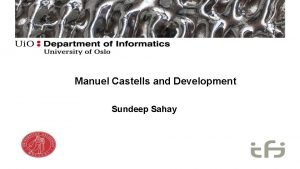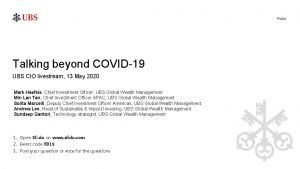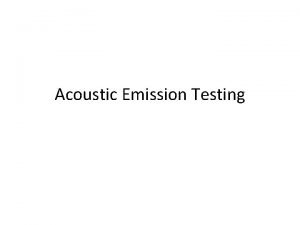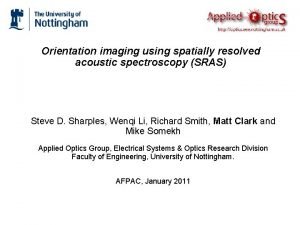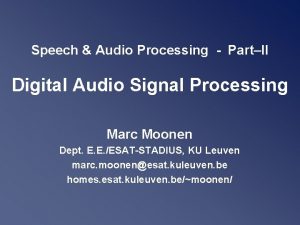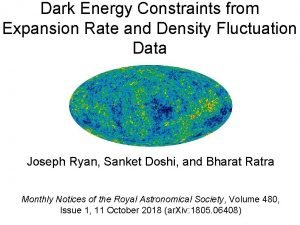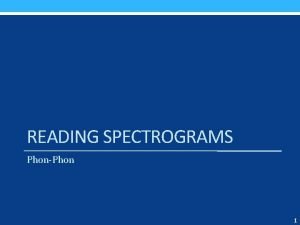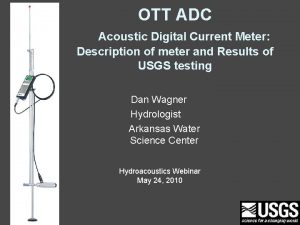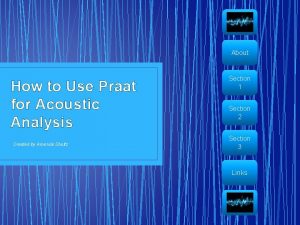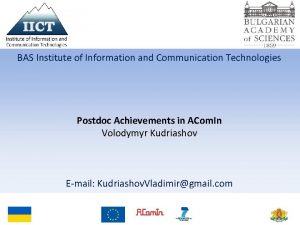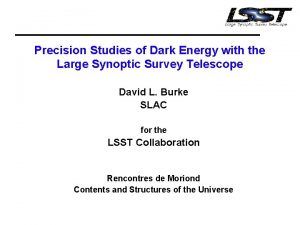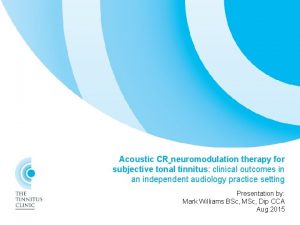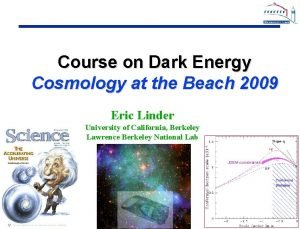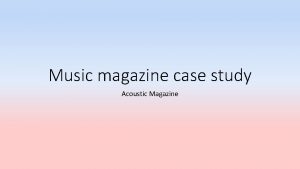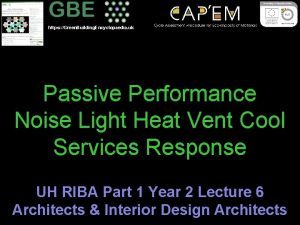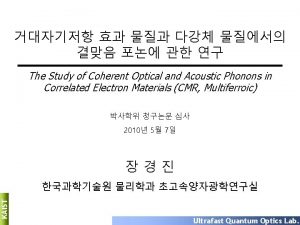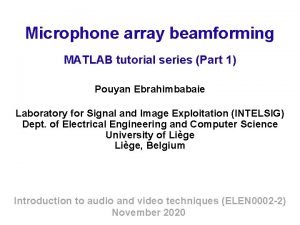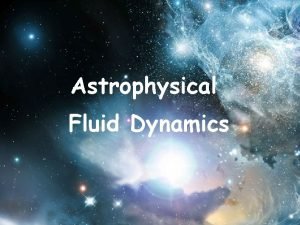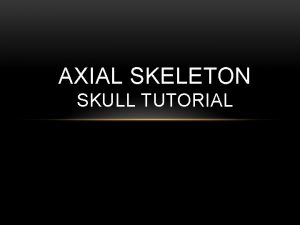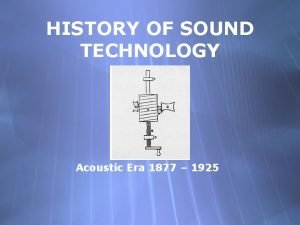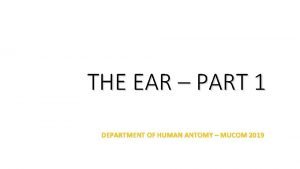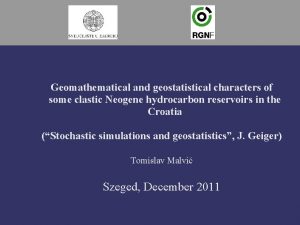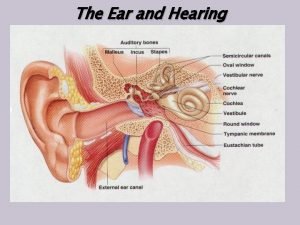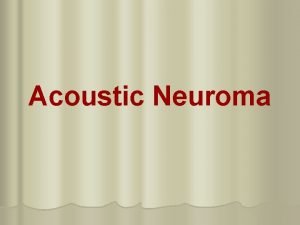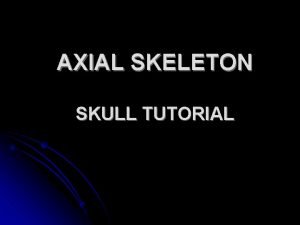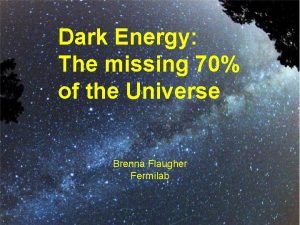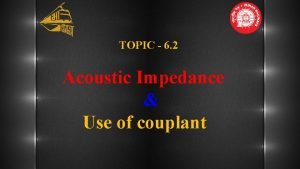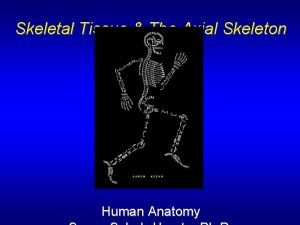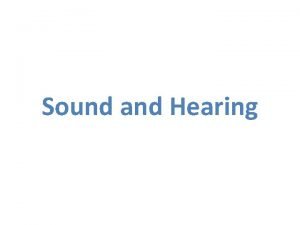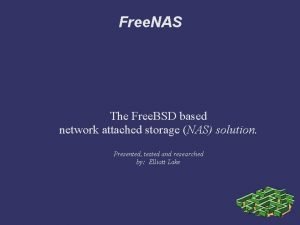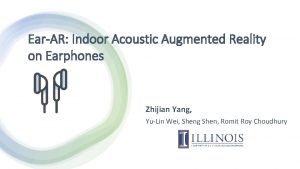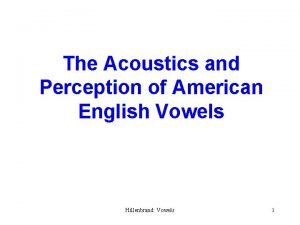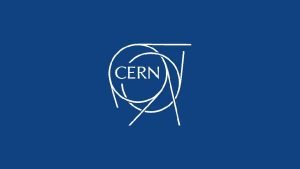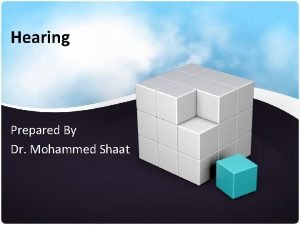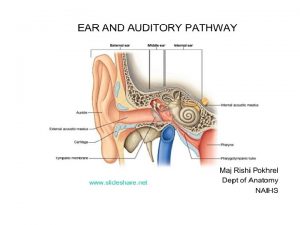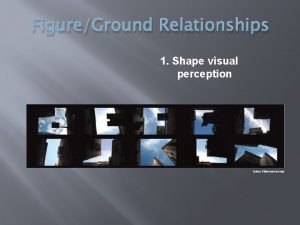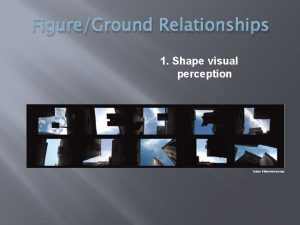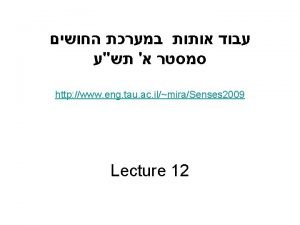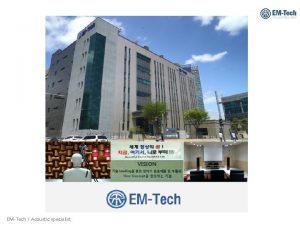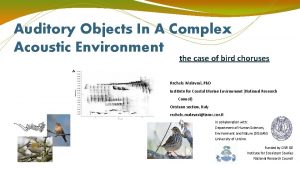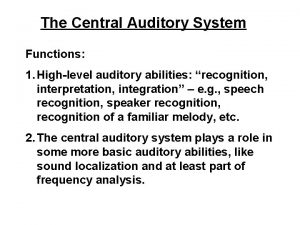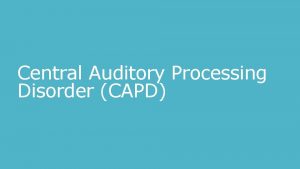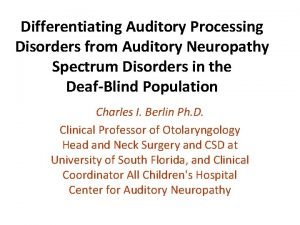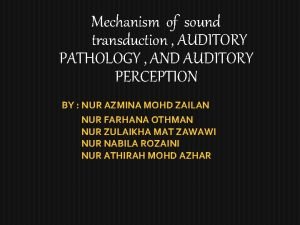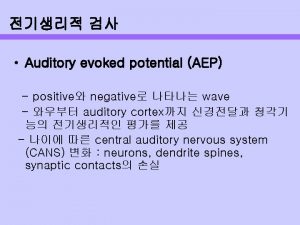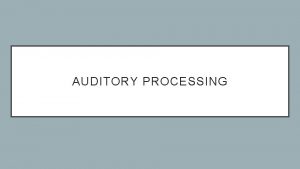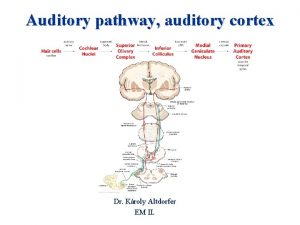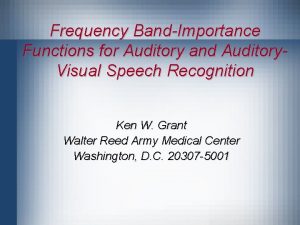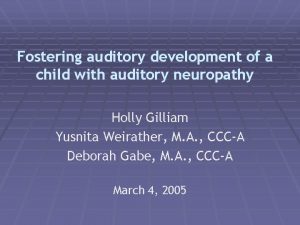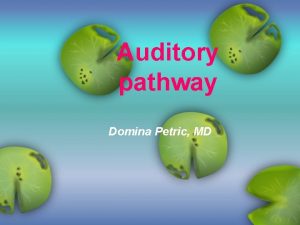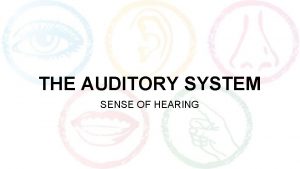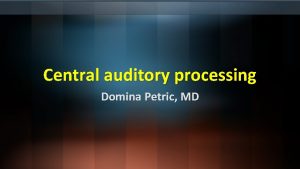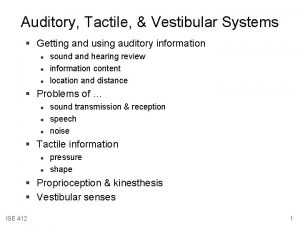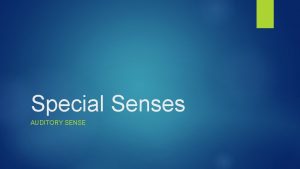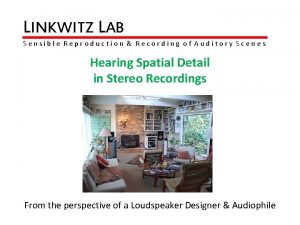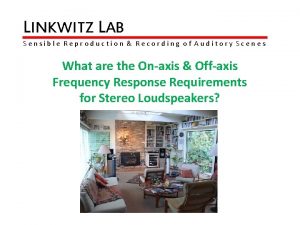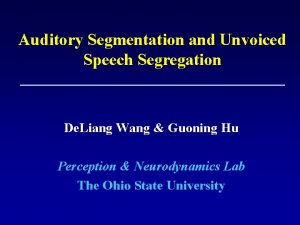Auditory figureground segregation in complex acoustic scenes Sundeep





















![Expt. 1: ‘Baseline’ (50 ms) Coherence: [1 2 4 6 8] Duration: [2: 7] Expt. 1: ‘Baseline’ (50 ms) Coherence: [1 2 4 6 8] Duration: [2: 7]](https://slidetodoc.com/presentation_image/42f9f4e6c1a4f1c1dd276c4d7a74d1ba/image-22.jpg)























- Slides: 45

Auditory figure-ground segregation in complex acoustic scenes Sundeep Teki Wellcome Trust Centre for Neuroimaging University College London, UK

Outline § Figure-ground stimulus § f. MRI study § Psychophysics § Modelling § MEG study § Depth electrode study? 2

The problem 3

Stimuli 4

Stochastic Figure-Ground (SFG) 5

SFG: Figure present 6

SFG: Stimulus design Stimulus: Duration of each chord: Inter-chord interval: Total stimulus duration: 50 ms 2000 ms (40 consecutive chords) Chords: No. of pure tone components: Component frequency range: Resolution of frequency pool: Cosine ramp: 5 -15 179 – 7246 Hz 1/24 th of an octave 10 ms for onset and offset Coherence: Number of different repeating frequencies : 1, 2, 4, 6, 8 Duration: Number of chords over which frequencies repeat : 2 -7 7

Features of SFG • Figure and background signals do not differ in low-level acoustic attributes • No spectral ‘protective’ region between figure and background • Figure and background signals are indistinguishable at each point in time • Figure can only be extracted by integrating over time and frequency • Enables parametric variation of figure salience 8

Outline § Figure-ground stimulus § f. MRI study § Psychophysics § Modelling § MEG study § Depth electrode study? 9

Behaviour n=10 Ø Listeners are remarkably sensitive to the appearance of figures Ø Sensitive to parametric variations of coherence and duration 10

Behaviour in scanner 11

f. MRI design time (fixed coherence) ISI=mean Figure 2 sec (jitter between 1. 5 -5) + 30% null events Figure (fixed duration) Background Decoy Task: Detect decoy stimuli (noise bursts; 10% of stimuli) Ø Subjects were not actively detecting figures 12

f. MRI analysis 14 subjects (normal hearing, no audiological disorders) Standard pre-processing with SPM 8 Whole brain analysis ISI=mean 2 sec (jitter between 1. 5 -5) + 30% null events Statistical model based on General Linear Model Random effects design Parametric Modulation: I. Effect of Duration: Fixed coherence (4); varying duration (2 -7) II. Effect of Coherence: Fixed duration (4); varying coherence (1, 2, 4, 6, 8) 13

f. MRI Results I. Effects of Duration: Intraparietal Sulcus (IPS) (bilateral; anterior) Superior Temporal Sulcus (STS) (bilateral) Planum Temporale (R) Medial Geniculate Body (MGB) (bilateral) 14

Effects of Duration 15

f. MRI Results II. Effects of Coherence: Intraparietal Sulcus (bilateral; posterior) Superior Temporal Sulcus (bilateral) 16

Effects of Coherence 17

What about the auditory cortex ? § No activation in Primary Auditory Cortex (PAC) for either contrast § Confirmed using volume of interest analysis based on PAC maps (Morosan et al. , 01) § Consistent with one previous f. MRI study (Cusack, 2005) Reasons… § More complex and naturalistic stimulus § Naïve subjects and short figures § PAC recruited during active figure-ground segregation (i. e. , in behavioural context) with possibly top-down modulation by IPS? Role of STS § STS activity modulated by changing duration and coherence of the figure § Implicated in: - analysis of spectral shape (Warren et al. , 2005) - dynamic changes in spectrum (Overath et al. , 2008) - detection of changes in spectrotemporal coherence within textures (Overath et al. , 2010) 18

IPS and Perceptual Organization Role of IPS consistent with Cusack (2005): § Implicated IPS in perception of two streams vs. one stream, based on the same physical streaming signal that evoked a bistable percept. IPS activity likely reflects top-down application of attention (shift between streams) Found no activation in primary auditory cortex § § IPS is involved in structuring sensory input and perceptual organization: § § § Encoding visual object representations Binding of sensory features within and across different modalities control and shift of auditory attention What does the IPS activity reflect? Ø automatic, bottom-up segregation of auditory object from stochastic background 19

Outline § Figure-ground stimulus § f. MRI study § Psychophysics § Modelling § MEG study § Depth electrode study? 20

Psychophysics Aims: § To characterize the brain mechanisms that underlie complex figure-ground segregation through systematic manipulations of the SFG stimulus § To examine sensitivity to figures by introducing systematic perturbations § Test role of adaptation in mediating segregation in our complex stimulus 21
![Expt 1 Baseline 50 ms Coherence 1 2 4 6 8 Duration 2 7 Expt. 1: ‘Baseline’ (50 ms) Coherence: [1 2 4 6 8] Duration: [2: 7]](https://slidetodoc.com/presentation_image/42f9f4e6c1a4f1c1dd276c4d7a74d1ba/image-22.jpg)
Expt. 1: ‘Baseline’ (50 ms) Coherence: [1 2 4 6 8] Duration: [2: 7] 22

Expt. 1: Results (n=9) 23

Psychophysics 24

Psychophysics summary Figure-detection performance in complex SFG stimulus is: § Depends on no. of repeating chords, not duration of figure (Expt. 1 & 2) § Invariant to disruption by white noise (Expt. 1 & 3) § Sensitive to shape of figure (continuous vs. ramped) (Expt. 1 & 4) § Sensitive to size of ramps (2 vs. 5) (Expt. 4 a & 4 b) § Invariant to the presence of preceding background (Expt. 1 & 5) 25

Outline § Figure-ground stimulus § f. MRI study § Psychophysics § Modelling § MEG study § Depth electrode study? 26

Temporal coherence model (Chi et al. , 2005; Elhilali et al. , 2009; Shamma et al. , 2011) 27

Temporal coherence model STIMULUS SPECTROGRAM FEATURE ANALYSIS COHERENCE ANALYSIS DYNAMIC COHERENCE MATRIX Chi et al. , 2005; JASA Elhilali and Shamma, 2008; JASA Elhilali et al. , 2009; Neuron 28 Shamma et al. , 2011 Ti. NS

Temporal coherence & Streaming Elhilali et al. , 2009 29

Temporal coherence & SFG Hypotheses: Channels with repeating frequency components would be temporally coherent; and these components may be grouped together and perceived as a single object. Parameters of the model: Temporal modulation: 20 Hz (tuned to chord repetition period of 50 ms) Spectral resolution: 8 cyc/oct. (corresponding to BW in streaming) 30

Modelling expt 5 (‘isolated’) I. Input: Different examples of figure and ground stimuli for each (coh, dur) x 1000 31

Coherence matrix (figure present) Coherence matrix (figure absent) § Measure: 1 st eigen value from PCA of coherence matrix 32

§ Output: 1 st eigen value (figure) - 1 st eigen value(ground) 33

Outline § Figure-ground stimulus § f. MRI study § Psychophysics § Modelling § MEG study § Depth electrode study? 34

1. Basic Figure onset 35

2. SFG + Noise 36 Teki, Chait et al. , (in preparation

Stimulus details Stimuli: • Basic SFG • Noise + SFG X • Frequency range: 170 -2500 Hz • Conditions: - no figure (50%) - coherence 2 (16. 67%) - coherence 4 (16. 67%) - coherence 8 (16. 67%) • 100 trials/condition 37

MEG Task Subjects naïve to the auditory stimuli. Performing an irrelevant visual task: -> Respond if image 3 is same as 1 or 2 1 2 3 time 38

Analysis Evoked analysis (to examine temporal dynamics of the responses to the different figures) Source localization using VB-ECD Time-Frequency analysis to identify changes in brain rhythms following figure emergence Induced response analysis using Quadratic Component Analysis (de Cheveigne, 2012; Neuro. Image) 39

Hypotheses: Evoked responses: Early responses from auditory cortex reflect extraction of spectrotemporal regularities. Later responses might involve effects mediated by IPS Effects of noise? (latency scaled by 2? ) Induced responses: Gamma correlate of figure-following response 40

Pilot data: Basic SFG Coh 8 Coh 4 Coh 2 No figure 41

Outline § Figure-ground stimulus § f. MRI study § Psychophysics § Modelling § MEG study § Depth electrode study? 42

Depth electrode study? HYPOTHESES Auditory cortex activity peaks early at transition and may not be sensitive to the coherence of the figure IPS/Parietal activity peaks later and shows sensitivity to the different coherence values of the figure Abstraction of figure may be correlated with gamma ANALYSIS Evoked transition responses Time-frequency: induced figure-following response Temporal coherence modelling. . . 43

Summary Ø SFG stimulus: Listeners can segregate figure from ongoing background very well. Ø f. MRI: Areas outside the auditory system, such as IPS are involved in segregation in complex acoustic scenes Ø Psychophysics: Adaptation is not critical for complex auditory segregation. Ø Temporal coherence model: Can explain figure-ground segregation in complex acoustic scenes. Ø MEG: Evaluate transitions from background to segments with different salience Ø Depth electrode recordings: Look at source-space directly for transition and induced responses 44

Thanks to. . . Deborah Williams Maria Chait Sukhbinder Kumar, Aiysha Siddiq Timothy D. Griffiths Nicolas Barascud Newcastle Auditory Group UCL Ear Institute Shihab Shamma University of Marlyand, College Park 45
 Sundeep sahay
Sundeep sahay Ubs livestream
Ubs livestream Sundeep batavia
Sundeep batavia Application of acoustic emission testing
Application of acoustic emission testing Spatially resolved acoustic spectroscopy
Spatially resolved acoustic spectroscopy Digital audio and speech
Digital audio and speech Baryon acoustic oscillations
Baryon acoustic oscillations Reading spectrograms
Reading spectrograms Ott adc
Ott adc How to measure vot in praat
How to measure vot in praat B&k acoustic camera
B&k acoustic camera Baryon acoustic oscillations
Baryon acoustic oscillations Acoustic cr
Acoustic cr Baryon acoustic oscillations
Baryon acoustic oscillations Acoustic magazine uk
Acoustic magazine uk Acoustic materials
Acoustic materials Optical vs acoustic phonons
Optical vs acoustic phonons Matlab beamforming
Matlab beamforming Baryonic acoustic oscillations
Baryonic acoustic oscillations Lecture hall acoustic design
Lecture hall acoustic design External acoustic meatus
External acoustic meatus Acoustic era
Acoustic era Antomy of the ear
Antomy of the ear Acoustic warrant officer
Acoustic warrant officer Acoustic impedance
Acoustic impedance What is the function of the external acoustic meatus
What is the function of the external acoustic meatus Acoustic meatus
Acoustic meatus Rollover phenomenon in acoustic neuroma
Rollover phenomenon in acoustic neuroma Vomer
Vomer Baryon acoustic oscillations
Baryon acoustic oscillations Acoustic impedance of steel
Acoustic impedance of steel Foramen lacerum
Foramen lacerum Acoustic stimulus is
Acoustic stimulus is Nas bsd
Nas bsd Ear-ar: indoor acoustic augmented reality on earphones
Ear-ar: indoor acoustic augmented reality on earphones Acoustic characteristics of american english vowels
Acoustic characteristics of american english vowels Simple compound complex rules
Simple compound complex rules Freud complexes
Freud complexes Bruno dislikes sitting on the beach
Bruno dislikes sitting on the beach Psychoanalytic theory defense mechanisms
Psychoanalytic theory defense mechanisms Droplet infection
Droplet infection Uniquisitive
Uniquisitive Flynn's taxonomy
Flynn's taxonomy Mohammed
Mohammed Types of auditory hallucinations
Types of auditory hallucinations Crus helix
Crus helix
